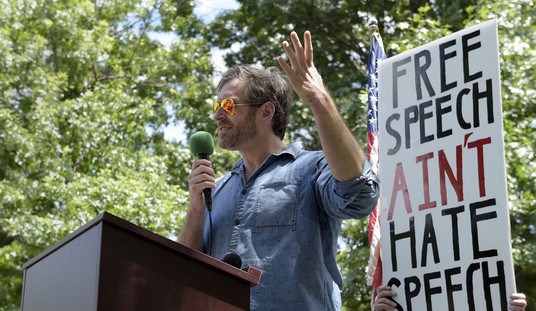Jules Crittenden reviews the first episode of Tom Hanks’ The Pacific miniseries on HBO, in light of Hanks recent shameful comments to Time magazine (owned by Time-Warner, which also owns the HBO channel and HBO Films, which co-produced the series). Jules writes:
If “The Pacific” delivers us blissfully out of the opening soap opera scenes and drops us unceremoniously into Guadalcanal, it does so without much of the context that illustrated the forging of a unit and the transformation of young men into warriors that was one of the strengths of BoB. The Guadalcanal scenes are beautifully shot but poorly edited, having the effect of being more of a horrific montage, lacking the impact they could have had, while the lead characters are effectively strangers. For all the nudge-nudge-get-it dialogue and meaningful looks, little effort has been made to put you cinematically into the minds of these young men. I also came away with the sense that the filmmakers are going to carefully balance out every Japanese atrocity with some example of the enemy’s humanity, every dehumanization of young American boys with an American boy’s thoughtful, chin-scratching realization that the hated Jap is just like him. A regrettable tendency to lecture, hector and handhold that underestimates the audience.
Jules adds, “would anyone expect them to bend over backwards to humanize the SS?” Didn’t The Reader, which I watched last week on DirecTV for the first time attempt to do just that? It begins — SPOILER ALERT! — as a sort of pedophilic version of The Night Porter with the genders reversed, then attempts to excuse the former SS guard character played by Kate Winslet for not knowing she was condemning Jews to death because she’s illiterate.
Can you say metaphor, boys und girls? I knew that you could. But as Ron Rosenbaum writes, in a spot-on review of the film last year at Salon:
Indeed, so much is made of the deep, deep exculpatory shame of illiteracy—despite the fact that burning 300 people to death doesn’t require reading skills—that some worshipful accounts of the novel (by those who buy into its ludicrous premise, perhaps because it’s been declared “classic” and “profound”) actually seem to affirm that illiteracy is something more to be ashamed of than participating in mass murder. From the Barnes & Noble Web site summary of the novel: “Michael recognizes his former lover on the stand, accused of a hideous crime. And as he watches Hanna refuse to defend herself against the charges, Michael gradually realizes that she may be guarding a secret more shameful than murder.” Yes, more shameful than murder! Lack of reading skills is more disgraceful than listening in bovine silence to the screams of 300 people as they are burned to death behind the locked doors of a church you’re guarding to prevent them from escaping the flames. Which is what Hanna did, although, of course, it’s not shown in the film. As I learned from the director at a screening of The Reader, the scene was omitted because it might have “unbalanced” our view of Hanna, given too much weight to the mass murder she committed, as opposed to her lack of reading skills. Made it more difficult to develop empathy for her, although it’s never explained why it’s important that we should.
Using extensive and fairly believable make-up effects, the film depicts Winslet’s heavily aged character spending decades in a prison cell rather than confess to her illiteracy. At the film’s climax, after teaching herself how to read — and keeping with the metaphor of the film, presumably beginning to understand the crimes she was involved in, Winslet’s character hangs herself from the ceiling of her prison cell, after first climbing on top of a desk containing the books that she had taken out from the prison library.
As Rod Lurie writes at the Huffington Post, the Reader’s coda adds one final insult on top of the the rest of its facile metaphors, all designed by author Bernhard Schlink to excuse his fellow Germans of their guilt:
The hollowest scene is the one I am sure was intended to be the film’s most redemptive. A grown up Michael goes to see a survivor of the very church burning Hanna was involved with. She lectures him about the camps and refuses the money Hanna has willed to her (though she accepts the tin the money came in). The beautiful Lena Olin plays the survivor. She is well dressed. Her New York apartment is large and gorgeously furnished, her art collection on display.
In the scenes preceding it we see Hanna. She has nothing. She is in bad health. She commits suicide.
So, the SS representative in the film ends up pathetic and sad and, by the way, not guilty of the crime for which she was sentenced.
The lone representative of the survivors is haughty and glamorous — a near perfect (and negative) stereotype of the wealthy European Jew in New York.
Guess whom the audience can relate to more?
So, sure, I don’t have to imagine Hollywood bending over backwards to humanize the SS. I just watched it last week in HD on Showtime.
Related: “Recognize this Photo? Well, Some Professional Journalists Don’t.”










Join the conversation as a VIP Member